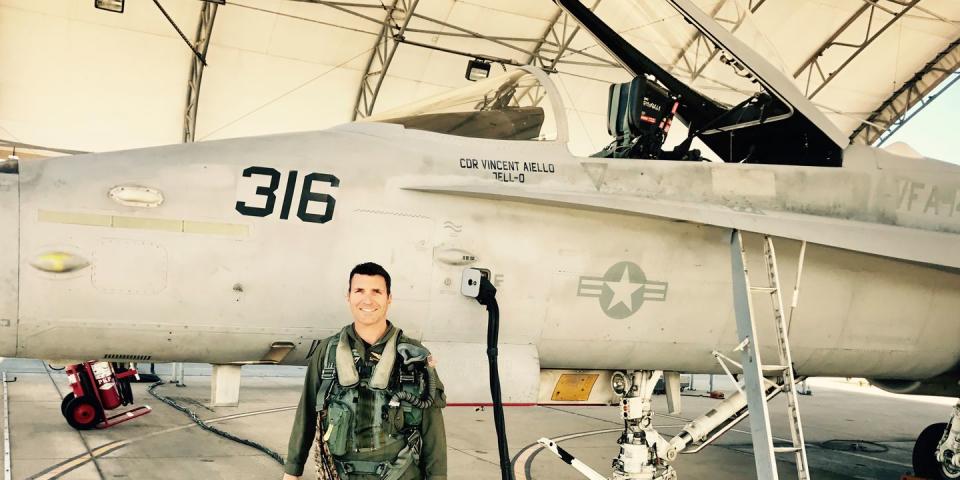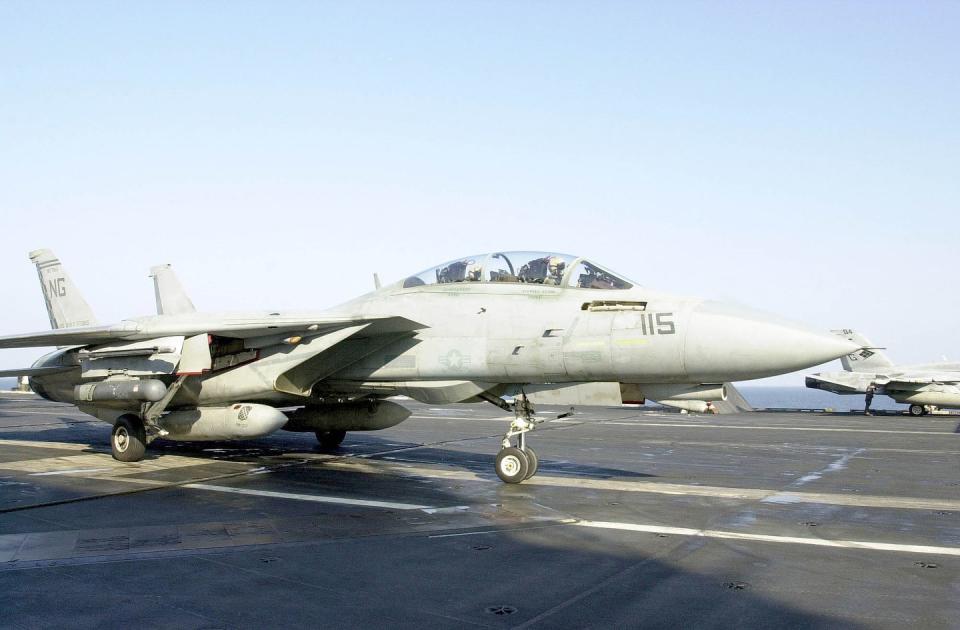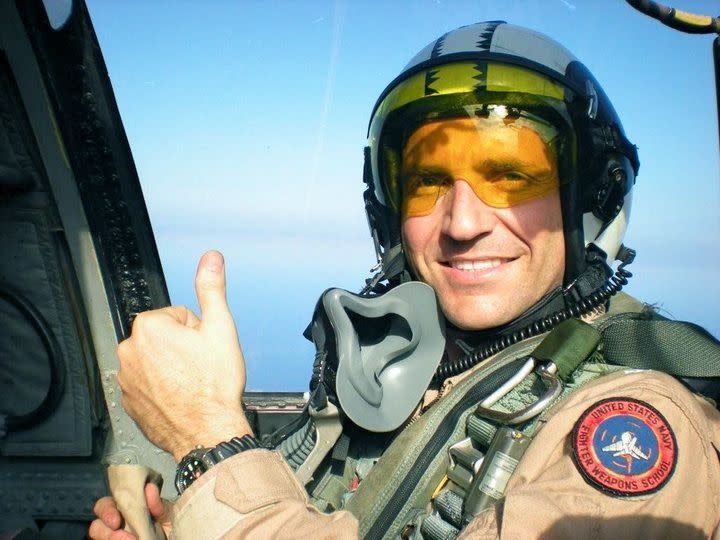9 Questions With a Former TOPGUN Pilot

Vincent “Jell-O” Aiello was a U.S. naval aviator from 1992 to 2017, flying the F/A-18C Hornet and F/A-18E/F Super Hornet strike fighters. Aiello has 3,800 flight hours in the cockpit, over 700 carrier landings, and nearly 70 missions flown in Iraq in Operations Southern Watch and Iraqi Freedom under his belt.
In addition to his career at sea, Aiello was an instructor at the elite Navy Fighter Weapons School, otherwise known as TOPGUN. He’s a qualified Strike Fighter Tactics Instructor and flew the F-16 Fighting Falcon and A-4 Skyhawk as aggressor aircraft.
✈︎ Don’t miss any of our best-in-class military and defense coverage. Join our squad.
Today, Aiello is a pilot for a major air carrier and founder and host of The Fighter Pilot Podcast, the premiere internet radio show on all things warplanes. Now in its fifth year, the podcast has recorded 143 episodes on everything from the real-life TOPGUN program to World War II fighter planes like the Japanese Zero.
As the Top Gun: Maverick premiere (May 27) approaches, we check in with Jell-O to talk about the state of modern air warfare and which plane he’d choose to dogfight a Russian MiG. The interview has been lightly edited for brevity and clarity.

Popular Mechanics: Your bio says you were originally a Naval ROTC student at UCLA. Did you always intend to become a fighter pilot when you received your commission?
Vincent Aiello: Yes! Since I attended my first airshow at eight years old, I had a pretty good idea of what I wanted to do with my life. UCLA and NROTC were the path I chose to get me to the desired destination.
You flew the F/A-18 Hornet, F/A-18 Super Hornet, and F-16 Fighting Falcon during the military portion of your flying career. If you had to strap yourself into just one for a visual-range dogfight against a Russian MiG-29 multi-role fighter, which would you choose and why?
A high-lot F/A-18C Hornet, because it was what I had the most experience and proficiency flying, accruing more than 3,000 flight hours over a 25-year career.
Almost all American fighter jets are strike fighters, capable of both air-to-air and air-to-ground roles. It wasn’t always this way: we used to have dedicated fighters like the F-14A and dedicated attack jets like the A-7 Corsair. Do we accept any compromises by buying planes that do both?
Actually, the F-14 was designed with an air-to-surface capability, which was later used, and the A-7 did carry air-to-air missiles. Every aircraft features compromises no matter what it is designed to do, and no one model will be perfect at all roles—just as some automobiles are good for big families, while others are more sporty but carry fewer passengers. Tradeoffs are unavoidable in life; military aviation is no different.

The Fighter Pilot Podcast has covered dozens of types of aircraft, flying all sorts of roles, from fighters like Top Gun’s F-14 Tomcat to submarine hunters like the S-3 Viking. What’s the one type of aircraft missing from the U.S. arsenal today?
A pure dogfighter with limited systems and capabilities, but fantastic flight performance. Such a plane is missing because it is no longer necessary like the P-51 Mustang or F-86 Sabre of bygone eras.
Aircraft carriers, themselves, are becoming incredibly expensive, with the latest, USS Gerald R. Ford, coming in at a record-setting $13 billion. As a former air wing operations officer, do you think there’s room for a smaller, cheaper carrier in the fleet, or are big supercarriers worth the cost?
If as a nation you value freedom of navigation on the seas and the capability to project power around the world, “big supercarriers” as you call them, are absolutely worth the cost for the reasons my guests and I discuss on episode 136 titled “Centennial of U.S. Carriers.”
The war in Ukraine is pitting Ukraine’s air force against Russia’s, and the war is upending a lot of assumptions about modern warfare. Is there anything that surprises you about the conduct of the air war?
Yes. I am surprised Russia, with its superior numbers of troops and weapons, and the initiative, did not put the Ukrainian air force out of commission on day one. It speaks volumes both for the spirit of defending one’s homeland and the inefficacy of conscripts in an unjust war.

A lot of pundits said Ukraine’s Bayraktar drone could not survive against Russia’s air defenses, but it’s had an outsized role in this conflict. What conclusions can we draw from Ukraine’s use of Bayraktar drones in the war?
The nature of warfare continues to change—just as it has throughout human history. Small, inexpensive, and difficult-to-defend-against weapons may be the next iteration of armed combat.
The F-35 is equipped with the four-barrel GAU-22/A Gatling gun, but its fighting style is more of a stealthy ambusher, launching missiles at adversary jets beyond visual range. Is the gun an anachronism on the F-35? If not, what’s a situation where it might be used?
Only the F-35A is equipped with a built-in gun, the B and C models must attach an external pod. Every time designers think it’s a good idea to design a fighter plane without a gun, warfighters end up lamenting that decision. A gun is useful in close-in air-to-air dogfights and precise targeting of select ground targets where collateral damage is a concern. A gun (well, cannon really) remains fashionable as always.

The inevitable Top Gun question: Is it true that there’s a jar at the elite flying school and if anyone is caught quoting the movie they have to put money in it?
If so, it started after I left because I was there for almost three years between 2000 and 2002 and don’t remember seeing it. Now, I did pay small financial penalties for being late to briefs, saying something in the debrief someone else already said, calling a kill off an “invalid” shot, and a host of other offenses (which for me, quickly became expensive!). But I do not recall opening my wallet for a careless Top Gun quote.
You Might Also Like

 Yahoo Movies
Yahoo Movies 